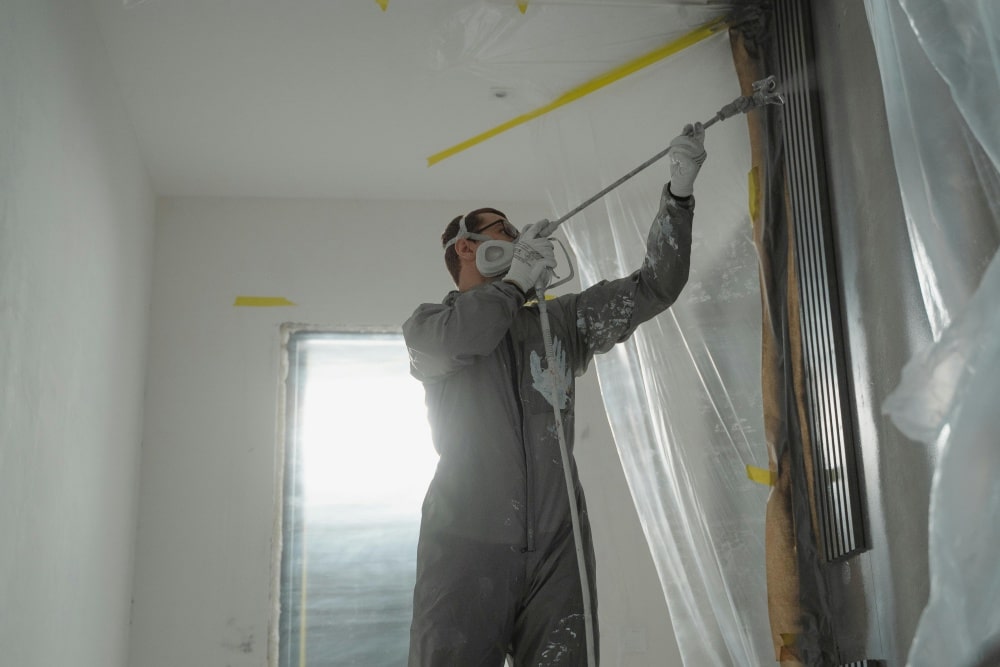
Enamel paint is one of the popular paint options for many home improvement projects, and for good reason! It’s known for its durability and ability to create a smooth, glossy finish that can really elevate the look of your doors, furniture, or even appliances.
But what exactly is enamel paint, and what makes this type of house paint so special?
What is Enamel Paint?
Definition and Overview
Enamel paint is a durable, glossy coating that dries to a hard finish, providing a smooth appearance on various surfaces. Known for its strength, this paint is commonly used in many types of buildings, including homes and offices. Enamel paints work by creating a solid, non-porous layer that protects surfaces from damage while enhancing their overall appearance with a sleek, shiny look. This makes it an excellent choice for projects like condo painting, where both durability and aesthetics are important.
Composition
Enamel paints, whether they are oil-based or water-based, share a similar composition. The main components consist of pigments, resins, and solvents. Pigments give the paint its colour and opacity, while resins serve as binders that hold the pigment particles together, creating a resistant film once the paint dries. Solvents are added to thin the paint for easier application and evaporate as the paint dries, which results in a glossy, durable painted surface.
While both types utilise solvents, the type of solvent impacts the drying time. Oil-based enamel paints, with their stronger solvents, have a longer drying time–up to 8 hours. In contrast, water-based paints dry much faster and have a milder odour, making them a popular choice for projects like HDB painting, where convenience is key.
Key Characteristics of Enamel Paint
1. Glossy, Hard Finish
One of the defining features of enamel paint is its glossy, hard finish, which results in a tough and smooth surface. This makes enamel an excellent choice for projects that need a professional, high-quality appearance. The glossy sheen also enhances the depth of the colour, making the painted surface look polished and refined.
2. Highly Durable
Enamel paint is highly durable, providing protection against wear and tear for years to come. Its resistance to scratching, chipping, and fading means that surfaces painted with enamel retain their fresh look for longer periods. This makes it ideal for high-traffic areas like kitchens, bathrooms, and outdoor spaces.
3. Moisture and Heat Resistant
Another great thing about enamel paint is its resistance to moisture and heat. This makes it a great choice for bathrooms, kitchens, and even outdoor furniture. You can rest assured that the paint won’t be easily damaged by humidity or high temperatures.
4. Ease of Cleaning and Maintenance
Enamel-painted surfaces are easy to clean and maintain. Their smooth, non-porous finish prevents dirt and grime from seeping in, making it simple to wipe down surfaces and keep them looking fresh. Therefore, enamel is a great option for surfaces exposed to frequent handling or spills.
Common Uses for Enamel Paint
Enamel paint is ideal for a variety of applications around the building. From walls to furniture, this type of paint is frequently chosen for its strength and polished finish.
Some of the common uses where enamel paint can deliver excellent results include.
- Interior Applications: Ideal for trim, doors, and kitchen cabinetry, adding a polished and sophisticated look to homes.
- Exterior Applications: Protects outdoor furniture and surfaces from weather elements, ensuring long-lasting appeal despite exposure to the elements.
- Appliances and Metal Surfaces: Refreshes the appearance of metal items like stoves and refrigerators while providing protection against rust and damage.
- Woodwork and Furniture: Enhances wooden furniture with a smooth, glossy finish that emphasises the wood’s natural beauty and offers lasting protection.
Types of Enamel Paint Finishes
Enamel paint comes in a variety of finishes, each offering a distinct appearance to match various needs and tastes. Whether you want a glossy shine or a more understated look, there’s an enamel finish that will be just right for your project.
- Glossy Finish: Offers a high-shine, polished appearance; ideal for an eye-catching look but can highlight surface imperfections.
- Semi-Gloss Finish: provides a moderate shine; perfect for trim work and doors.
- Satin Finish: A soft, elegant sheen, ideal for rooms that need a more understated look.
Pros and Cons of Using Enamel Paint
Understanding the pros and cons of using enamel paint can guide you in deciding if it’s a suitable choice for your next project. Here are some key points to consider regarding enamel paints:
Advantages:
- Hard, Protective Finish: Enamel paint creates a hard surface that resists damage from scratches, chips, and fading.
- Moisture and Heat Resistant: Ideal for areas with high humidity or exposure to heat, such as kitchens, bathrooms, and outdoor furniture.
- Long-Lasting: Enamel paint is built to last, making it an excellent investment for high-traffic areas or surfaces that experience significant wear and tear.
Disadvantages:
- Longer Drying Times: Especially for oil-based enamel paints, these types of paint tend to take longer to dry than water-based alternatives, which can extend project timelines.
- Strong Odour: Oil-based enamel paints have a strong smell. Therefore, it’s important to have good ventilation during application.
- Yellowing Over Time: Enamel paints are prone to yellowing with age, particularly when exposed to light.
Enamel Paint vs. Other Paint Types
Comparison with Acrylic Paint
Acrylic paint dries quickly, retains its colour over time, and offers a matte finish, which is often used for interiors. In contrast, enamel paint has a glossy finish and is commonly used for exteriors due to its durability, though it may turn yellow over time and require longer drying periods.
Comparison with Latex Paint
Enamel paint, especially oil-based, offers a more resistant surface and glossy finish, which makes it ideal for high-traffic areas, metal, and outdoor surfaces. Latex paint, being water-based, is quick-drying, more flexible, and suited for indoor walls and ceilings, offering various finishes like matte or eggshell.
How to Choose the Right Enamel Paint for Your Project
Before you dive into your painting project, it’s important to think about a few key factors to pick the best enamel paint:
- Project Type: Think about whether you’re painting furniture, metal surfaces, or trims. Different projects may require different finishes or types of enamel paint.
- Desired Finish: Do you want a high-shine, glossy finish or a more subtle satin look? Choose your paints based on your aesthetic preferences.
- Environment: Consider whether the paint will be used indoors or outdoors and if the surface will be exposed to heat or humidity.
By taking the time to consider these factors, you can choose the enamel paint that perfectly fits your project. Making a thoughtful choice will help ensure your painted surfaces not only look great but also last for years to come.
Tips For Homeowners
Preparation Tips
Before you begin, ensure the surface is clean and free from any dust or rust. To remove rust, use appropriate de-rusting chemicals according to the manufacturer’s instructions. To remove oil or grease, use a suitable degreaser or a solution of soap and water. Once clean, sand the surface with sandpaper to create a rough texture to help the enamel paint adhere better. Finally, prime the surface with a primer that is compatible with enamel paint. This will create a smooth base for the enamel, ensuring a more durable and even finish.
Best Tools for Application
For enamel paint, use brushes or rollers specifically designed for smooth finishes. A high-quality brush will help you achieve an even, streak-free application.
Here’s a quick guide to help you choose the best tools for your project:
- Natural Bristle Brushes: Ideal for oil-based enamel paints and large surfaces like walls and furniture. Their stiffness and paint-holding capacity ensure smooth, even coverage.
- Synthetic Bristle Brushes: Best suited for water-based enamel paints. They maintain their shape and stiffness when in contact with water, offering excellent control and a smooth application.
- Angled Brushes: Essential for cutting in around edges, corners, and trim. Their slanted bristles provide clean lines and precise application, reducing the need for masking tape.
- Foam Brushes: Perfect for smooth surfaces like cabinets and doors. They offer a streak-free finish and are disposable, making them convenient for quick projects or when using multiple colours.
- Fine Detail Brushes: Use these for intricate designs, touch-ups, or delicate painting work. Their thin tips allow for precise control and fine lines.
Application Techniques
To avoid brush strokes and ensure a smooth finish, apply thin coats of enamel paint, allowing each coat to dry before applying another. This will help you achieve a professional-looking result.
Drying and Curing Times
Oil-based enamel paints generally take longer to dry than water-based options. Be sure to allow adequate time for each coat to dry completely before applying more layers.
Safety Precautions
Always ensure proper ventilation when using oil-based enamel paints due to their strong odour. Wear protective gear, such as gloves and a mask, to minimise fume exposure.
Frequently Asked Questions About Enamel Paint
Can I use enamel paint on the walls?
Yes, enamel paint can be used on walls, but it’s more commonly used for trim, doors, and furniture due to its glossy finish.
How long does enamel paint take to dry?
Oil-based enamel paint can take up to 8 hours to dry, while water-based enamel dries faster, usually within 1 to 2 hours.
Do I need to sand between coats?
Yes, lightly sanding between coats helps create a smooth finish and improves paint adhesion.
Is water-based enamel as durable as oil-based?
Oil-based enamel paint dries harder, offering excellent wear resistance, but can crack over time due to a lack of flexibility. On the other hand, water-based paint is more flexible and can expand and contract with weather changes, making it last longer in fluctuating conditions.
What’s the best way to clean enamel-painted surfaces?
Make a solution of mild soap and use a soft cloth to clean enamel-painted surfaces, avoiding abrasive cleaners that could damage the finish.
Achieve a Flawless Enamel Finish with 5 Star Painting
Enamel paint is a fantastic option for projects that require a tough and attractive finish. Its durability, moisture resistance, and variety of finishes make it suitable for a wide range of applications in your home, from furniture and trim to metal surfaces.
However, we understand that achieving a flawless finish with enamel paint can sometimes be challenging. If you’re looking for professional results, consider 5 Star Painting’s expert painting services in Singapore. Our experienced team can handle all your enamel painting needs, ensuring a perfect, long-lasting finish every time.

